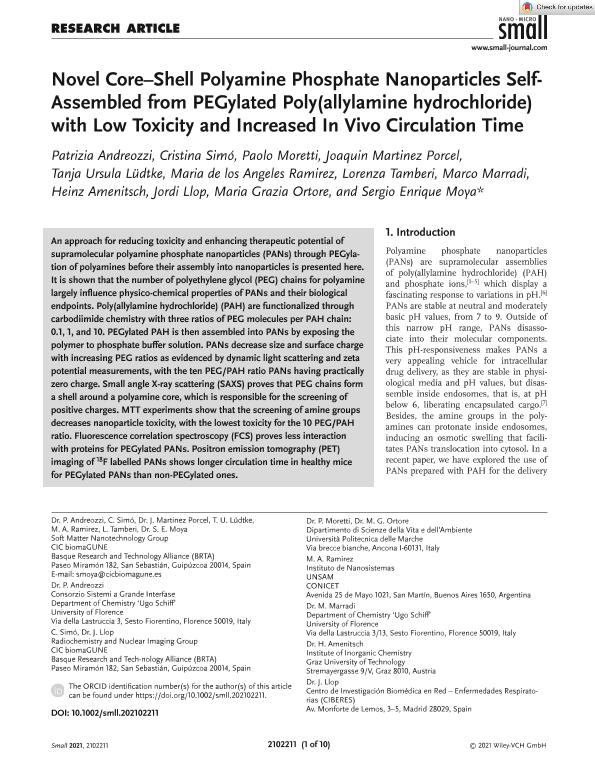Mostrar el registro sencillo del ítem
dc.contributor.author
Andreozzi, Patrizia
dc.contributor.author
Simó, Cristina
dc.contributor.author
Moretti, Paolo
dc.contributor.author
Martinez Porcel, Joaquin
dc.contributor.author
Lüdtke, Tanja Ursula
dc.contributor.author
Ramirez, Maria de Los Angeles

dc.contributor.author
Tamberi, Lorenza
dc.contributor.author
Marradi, Marco
dc.contributor.author
Amenitsch, Heinz
dc.contributor.author
Llop, Jordi
dc.contributor.author
Ortore, Maria Grazia
dc.contributor.author
Moya, Sergio Enrique
dc.date.available
2022-08-18T18:18:34Z
dc.date.issued
2021-09-02
dc.identifier.citation
Andreozzi, Patrizia; Simó, Cristina; Moretti, Paolo; Martinez Porcel, Joaquin; Lüdtke, Tanja Ursula; et al.; Novel Core–Shell Polyamine Phosphate Nanoparticles Self-Assembled from PEGylated Poly(allylamine hydrochloride) with Low Toxicity and Increased In Vivo Circulation Time; Wiley VCH Verlag; Small; 17; 35; 2-9-2021; 1-10
dc.identifier.issn
1613-6810
dc.identifier.uri
http://hdl.handle.net/11336/166058
dc.description.abstract
An approach for reducing toxicity and enhancing therapeutic potential of supramolecular polyamine phosphate nanoparticles (PANs) through PEGylation of polyamines before their assembly into nanoparticles is presented here. It is shown that the number of polyethylene glycol (PEG) chains for polyamine largely influence physico-chemical properties of PANs and their biological endpoints. Poly(allylamine hydrochloride) (PAH) are functionalized through carbodiimide chemistry with three ratios of PEG molecules per PAH chain: 0.1, 1, and 10. PEGylated PAH is then assembled into PANs by exposing the polymer to phosphate buffer solution. PANs decrease size and surface charge with increasing PEG ratios as evidenced by dynamic light scattering and zeta potential measurements, with the ten PEG/PAH ratio PANs having practically zero charge. Small angle X-ray scattering (SAXS) proves that PEG chains form a shell around a polyamine core, which is responsible for the screening of positive charges. MTT experiments show that the screening of amine groups decreases nanoparticle toxicity, with the lowest toxicity for the 10 PEG/PAH ratio. Fluorescence correlation spectroscopy (FCS) proves less interaction with proteins for PEGylated PANs. Positron emission tomography (PET) imaging of 18F labelled PANs shows longer circulation time in healthy mice for PEGylated PANs than non-PEGylated ones.
dc.format
application/pdf
dc.language.iso
eng
dc.publisher
Wiley VCH Verlag

dc.rights
info:eu-repo/semantics/openAccess
dc.rights.uri
https://creativecommons.org/licenses/by-nc-sa/2.5/ar/
dc.subject
BIOLOGICAL FATE
dc.subject
POLYAMINE PHOSPHATE NANOPARTICLES
dc.subject
POLYETHYLENE GLYCOL
dc.subject
SELF ASSEMBLY
dc.subject
SMALL ANGLE X-RAY SCATTERING
dc.subject.classification
Otras Ciencias Químicas

dc.subject.classification
Ciencias Químicas

dc.subject.classification
CIENCIAS NATURALES Y EXACTAS

dc.title
Novel Core–Shell Polyamine Phosphate Nanoparticles Self-Assembled from PEGylated Poly(allylamine hydrochloride) with Low Toxicity and Increased In Vivo Circulation Time
dc.type
info:eu-repo/semantics/article
dc.type
info:ar-repo/semantics/artículo
dc.type
info:eu-repo/semantics/publishedVersion
dc.date.updated
2022-08-16T18:12:34Z
dc.identifier.eissn
1613-6829
dc.journal.volume
17
dc.journal.number
35
dc.journal.pagination
1-10
dc.journal.pais
Alemania

dc.journal.ciudad
Weinheim
dc.description.fil
Fil: Andreozzi, Patrizia. Basque Research and Technology Alliance; España. Università degli Studi di Firenze; Italia
dc.description.fil
Fil: Simó, Cristina. Basque Research and Technology Alliance; España
dc.description.fil
Fil: Moretti, Paolo. Università Politecnica delle Marche; Italia
dc.description.fil
Fil: Martinez Porcel, Joaquin. Basque Research and Technology Alliance; España
dc.description.fil
Fil: Lüdtke, Tanja Ursula. Basque Research and Technology Alliance; España
dc.description.fil
Fil: Ramirez, Maria de Los Angeles. Basque Research and Technology Alliance; España. Universidad Nacional de San Martin. Instituto de Nanosistemas; Argentina. Consejo Nacional de Investigaciones Científicas y Técnicas; Argentina
dc.description.fil
Fil: Tamberi, Lorenza. Basque Research and Technology Alliance; España
dc.description.fil
Fil: Marradi, Marco. Università degli Studi di Firenze; Italia
dc.description.fil
Fil: Amenitsch, Heinz. Graz University Of Technology.; Austria
dc.description.fil
Fil: Llop, Jordi. Basque Research and Technology Alliance; España. Centro de Investigación Biomédica En Red de Enfermedades Respiratorias; España
dc.description.fil
Fil: Ortore, Maria Grazia. Università Politecnica Delle Marche; Italia
dc.description.fil
Fil: Moya, Sergio Enrique. Basque Research and Technology Alliance; España
dc.journal.title
Small

dc.relation.alternativeid
info:eu-repo/semantics/altIdentifier/url/https://onlinelibrary.wiley.com/doi/10.1002/smll.202102211
dc.relation.alternativeid
info:eu-repo/semantics/altIdentifier/doi/http://dx.doi.org/10.1002/smll.202102211
Archivos asociados
